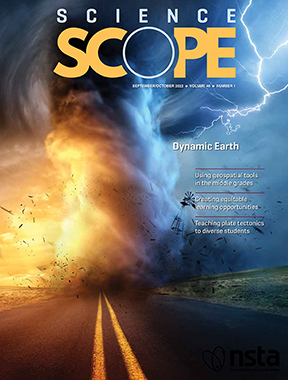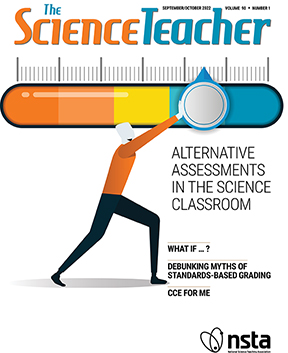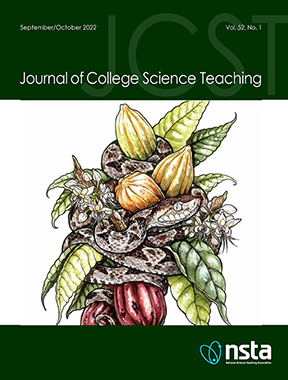the poetry of science
Joyful Science
Science and Children—September/October 2022 (Volume 60, Issue 1)
By Sylvia Vardell and Janet Wong
teaching through trade books
Starting With Science
Science and Children—September/October 2022 (Volume 60, Issue 1)
By Christine Anne Royce
From the Field: Freebies and Opportunities for Science and STEM Teachers, September 6, 2022
By Debra Shapiro

Tech Talk
Joyful Science
Science and Children—September/October 2022 (Volume 60, Issue 1)
By Heather Pacheco-Guffrey
The early years
Preschoolers’ Science Learning Can Be Joyful—Using a Play-Based, Project Approach
Science and Children—September/October 2022 (Volume 60, Issue 1)
By Shelly Lynn Counsell
Editor's Note
Joyful Science
Science and Children—September/October 2022 (Volume 60, Issue 1)
By Elizabeth Barrett-Zahn

Volume 46, Number 1
Dynamic Earth

Volume 46, Number 1
Dynamic Earth

Volume 46, Number 1
Dynamic Earth

Volume 90, Number 1
Alternative Assessments in the Science Classroom
When I say “assessments,” what immediately comes to your mind? Tests, quizzes, and exams? Does it always have to be that way?
As you know, there are two main categories of assessments.

Volume 90, Number 1
Alternative Assessments in the Science Classroom
When I say “assessments,” what immediately comes to your mind? Tests, quizzes, and exams? Does it always have to be that way?
As you know, there are two main categories of assessments.

Volume 90, Number 1
Alternative Assessments in the Science Classroom
When I say “assessments,” what immediately comes to your mind? Tests, quizzes, and exams? Does it always have to be that way?
As you know, there are two main categories of assessments.
Research & Teaching
Cross-Disciplinary Learning
A Framework for Assessing Application of Concepts Across Science Disciplines
Journal of College Science Teaching—September/October 2022 (Volume 52, Issue 1)
By Emily Borda, Todd Haskell, and Andrew Boudreaux
We propose cross-disciplinary learning as a construct that can guide instruction and assessment in programs that feature sequential learning across multiple science disciplines. Cross-disciplinary learning combines insights from interdisciplinary learning, transfer, and resources frameworks and highlights the processes of resource activation, transformation, and integration to support sense-making in a novel disciplinary context by drawing on knowledge from other prerequisite disciplines. In this article, we describe two measurement approaches based on this construct: (a) a paired multiple choice instrument set to measure the extent of cross-disciplinary learning; and (b) a think-aloud interview approach to provide insights into which resources are activated, and how they are used, when making sense of an unfamiliar phenomenon. We offer implications for program and course assessment.



